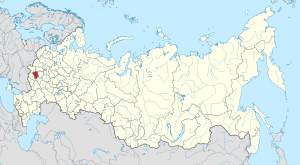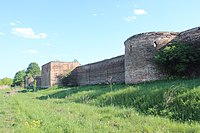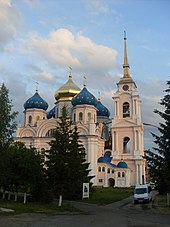Oryol Oblast
Oryol Oblast | |
|---|---|
| Орловская область | |
 | |
| Coordinates: 52°51′N 36°26′E / 52.850°N 36.433°E | |
| Country | Russia |
| Federal district | Central[1] |
| Economic region | Central[2] |
| Administrative center | Oryol |
| Government | |
| • Body | Oblast Council of People's Deputies |
| • Governor | Andrey Klychkov[3] |
| Area | |
| • Total | 24,652 km2 (9,518 sq mi) |
| • Rank | 71st |
| Population | |
| • Total | 713,374 |
| • Estimate (2018)[6] | 747,247 |
| • Rank | 62nd |
| • Density | 29/km2 (75/sq mi) |
| • Urban | 66.6% |
| • Rural | 33.4% |
| Time zone | UTC+3 (MSK |
| ISO 3166 code | RU-ORL |
| License plates | 57 |
| OKTMO ID | 54000000 |
| Official languages | Russian[8] |
| Website | http://www.adm.orel.ru/ |
Oryol Oblast (Russian: Орло́вская о́бласть, romanized: Orlovskaya oblast'), also known as Orlovshchina (Орловщина), is a federal subject of Russia (an oblast). Its administrative center is the city of Oryol. Population: 713,374 (2021 Census);[9] 786,935 (2010 Census);[10]
Geography


It is located in the southwestern part of the Central Federal District, in the Central Russian Upland.
In terms of area, at 24,652 km2 (9,518 sq mi) it is one of the smallest federal subjects.[11] From north to south, it extends for more than 150 km (93 mi), and from west to east—for over 200 km (120 mi).
Kaluga Oblast border it to the north-west; Tula Oblast is located to the north; Lipetsk Oblast — to the east; Kursk Oblast — to the south, and Bryansk Oblast is to the west.
There are 4,800 km2 (1,900 sq mi) of black earth soils (chernozems) in the oblast, which amounts to three-quarters of the world chernozem reserves.[11]
Climate
The climate is temperate (Köppen: Dfb). The winter is moderately cold, with an average January temperature from −9 to −11 °C (16 to 12 °F). Summers are warm and humid, with an average July temperature from 19 to 21 °C (66 to 70 °F). Rainfall averages 520 to 630 mm (20 to 25 in), and snow cover averages 120 days.
Hydrography
On the territory of the Oryol region there are more than 2 thousand rivers and streams with a total length of 9,100 km (5,700 mi), but there are no navigable water ways. The rivers of the region belong to the basins of three rivers: Volga, Don, Dnieper.
The Oka river, one of Europe's largest rivers, flows through the oblast for part of its course (190 km) and the source of it is in the south of the region. Main tributaries: Zusha (with tributary Neruch), Vytebet, Nugr, Tson, Orlik, Rybnitsa, Kroma.
Sosna flows in the eastern part of the region. Main tributaries: Trudy, Tim, Lyubovsha, Kshen, Olym.
In the west of the region originate rivers Nerussa, Navlya, Swapa.
1100 lakes and artificial reservoirs of the region cover a total area of about 55 km2 (21 sq mi) (0,22%).
History

In the 12th century, chronicles mention Mtsensk, known as Novosil then. Then modern Orlovschina was part of the Chernigov Principality. After the death of Mikhail of Chernigov Novosil Principality was formed on these territories. By the end of the 15th century it had disintegrated into four separate principalities and, along with all the other fragments of the Chernigov principality, became a part of Grand Duchy of Lithuania. In the 16th century, the fortress town of Oryol was founded, and the town of Livny, destroyed in the 13th century, was restored. In the 16th and 17th centuries, the territory of modern Oryol was the borderland of the Tsardom of Russia, with many fortifications of the Great Abatis Line . With the reduction of the threat posed by the Tatars, agricultural activity of the area had intensified. It was created in 1937 by uniting a selection of territories of three other oblasts: Kursk Oblast, Western Oblast, and Voronezh Oblast. It also included present Bryansk Oblast between 1937 and 1944.
Politics

During the Soviet period, the high authority in the oblast was shared between three persons: The first secretary of the Oryol CPSU Committee (who in reality had the biggest authority), the chairman of the oblast Soviet (legislative power), and the Chairman of the oblast Executive Committee (executive power). Since 1991, CPSU lost all the power, and the head of the Oblast administration, and eventually the governor was appointed/elected alongside elected regional parliament.
The Charter of Oryol Oblast is the fundamental law of the region. The Oryol Oblast Council of People's Deputies is the province's standing legislative (representative) body. The Legislative Assembly exercises its authority by passing laws, resolutions, and other legal acts and by supervising the implementation and observance of the laws and other legal acts passed by it. The highest executive body is the Oblast Government, which includes territorial executive bodies such as district administrations, committees, and commissions that facilitate development and run the day to day matters of the province. The Oblast administration supports the activities of the Governor of Oryol Oblast, who is the highest official and acts as guarantor of the observance of the oblast Charter in accordance with the Constitution of Russia.
The head of administration of Oryol Oblast between 1993 and 2009 was Yegor Stroyev. Stroyev led the region for more than 20 years. In 1985 he became the first secretary of the regional committee of the CPSU, and after three years (in 1989-1991 he worked as secretary of the Central Committee of the CPSU), in 1991 he returned to Oryol, worked as the director of the Institute of Horticultural Crops Selection, and later was elected governor. On February 16, 2009 Russian President Dmitry Medvedev accepted Stroyev's voluntary retirement and nominated Alexander Kozlov as his replacement, which was approved by the Oryol Regional Council of People's Deputies.
Administrative divisions

- 3 cities under the oblast's jurisdiction
- 24 districts
- 13 urban-type settlements
- 223 rural settlements
Historical population Year Pop. ±% 1959 929,013 — 1970 931,028 +0.2% 1979 892,505 −4.1% 1989 890,636 −0.2% 2002 860,262 −3.4% 2010 786,935 −8.5% 2021 713,374 −9.3% Source: Census data
Economy
The main industries in Oryol Oblast are the food and light industries, engineering and metalworking, and ferrous and nonferrous metallurgy. The engineering and metalworking industries manufacture production equipment for various industries, forklift trucks, construction and agricultural equipment, and machinery for municipal services. Numerous companies in the instrument-making and electronics sectors maintain high scientific and technical potential with the latest high-end technologies and experienced specialists.[12] First digital telephone exchange was introduced in the oblast in 1998.[13]
Agriculture
Most of the oblast's agricultural land is used for plant cultivation. Grain growing is very important, with winter wheat and rye being the main crops. Buckwheat, oats, barley, and potatoes are also grown, and sugar beets are in great demand. The area planted in feed grains is increasing due to the expansion of livestock farming, which includes beef and dairy cattle farming, pig farming, sheep farming for meat and wool, poultry farming, and horse breeding.[14]
Transport
Pipelines and power transmission lines are routed through the region's largest oil-trunk pipeline Druzhba (202 km in area). In the southwestern part of the area lies a small section of the Urengoy - Pomary - Uzhgorod pipeline.
Oryol is a major hub of pipelines exporting to Belarus, Western Ukraine and the Baltic states, with branches passing through Bryansk and Kursk.
Automotive

As of 2016, the motorization level of the area was of 314 cars per 1000 people, which is the 15th of any region of Russia and above the national average (285).
Main roads of the region:

 E105 / M 2 "Crimea" (152 km through Mtsensk, Oryol, Kromy, Trosna)
E105 / M 2 "Crimea" (152 km through Mtsensk, Oryol, Kromy, Trosna) R 119 Oryol — Tambov (151 km through Livny)
R 119 Oryol — Tambov (151 km through Livny) R 120 Oryol — Vitebsk (57 km through Naryshkino)
R 120 Oryol — Vitebsk (57 km through Naryshkino) R 92 Kaluga — Oryol (67 km through Bolkhov)
R 92 Kaluga — Oryol (67 km through Bolkhov)
 E391 / A 142 Trosna — Kalinovka (12 km)
E391 / A 142 Trosna — Kalinovka (12 km)- 54А-1 Oryol — Yefremov (158 km through Zalegoshch, Novosil)
Railway

The main line is the double track electrified main line Moscow - Kharkiv - Simferopol (136 km through Mtsensk, Oryol, Zmievka and Glazunovka).
Other lines:
- Oryol — Yelets (130 km through Zalegoshch, Verkhovye, Khomutovo and Krasnaya Zarya)
- historical Riga — Oryol (64 km through Naryshkino and Khotynets)
- Oryol — Dmitriyev (83 km through Kromy)
- Kursk Oblast — Kolpna (20 km)
Demographics



Population: 713,374 (2021 Census);[9] 786,935 (2010 Census);[10] 860,262 (2002 Census);[15] 890,636 (1989 Census).[16]
Vital statistics for 2022:[17][18]
- Births: 4,973 (7.0 per 1,000)
- Deaths: 12,247 (17.2 per 1,000)
Total fertility rate (2022):[19]
1.21 children per woman
Life expectancy (2021):[20]
Total — 68.97 years (male — 64.04, female — 73.81)
- Ethnic composition (2010):[10]
- Russians - 96.1%
- Ukrainians - 1%
- Others - 2.9%
- 17,468 people were registered from administrative databases, and could not declare an ethnicity. It is estimated that the proportion of ethnicities in this group is the same as that of the declared group.[21]
- Religion


According to a 2012 survey,[22] 40.9% of the population of Oryol Oblast adheres to the Russian Orthodox Church, 5% are unaffiliated generic Christians, 1% are Orthodox Christian believers who don't belong to church or belong to non-Russian Orthodox churches, 1% are adherents of the Rodnovery (Slavic native faith) movement, and 1% are Old Believers. In addition, 34% of the population declares to be "spiritual but not religious", 8% is atheist, and 9.1% follows other religions or did not give an answer to the question.[22]
References
- ^ Президент Российской Федерации. Указ №849 от 13 мая 2000 г. «О полномочном представителе Президента Российской Федерации в федеральном округе». Вступил в силу 13 мая 2000 г. Опубликован: "Собрание законодательства РФ", No. 20, ст. 2112, 15 мая 2000 г. (President of the Russian Federation. Decree #849 of May 13, 2000 On the Plenipotentiary Representative of the President of the Russian Federation in a Federal District. Effective as of May 13, 2000.).
- ^ Госстандарт Российской Федерации. №ОК 024-95 27 декабря 1995 г. «Общероссийский классификатор экономических регионов. 2. Экономические районы», в ред. Изменения №5/2001 ОКЭР. (Gosstandart of the Russian Federation. #OK 024-95 December 27, 1995 Russian Classification of Economic Regions. 2. Economic Regions, as amended by the Amendment #5/2001 OKER. ).
- ^ rbc.ru Putin Replaces Oryol Oblast Governor (in Russian)
- ^ "Сведения о наличии и распределении земель в Российской Федерации на 01.01.2019 (в разрезе субъектов Российской Федерации)". Federal Service for State Registration, Cadastre and Cartography. Archived from the original on 9 February 2022. Retrieved 29 August 2023.
- ^ "Оценка численности постоянного населения по субъектам Российской Федерации". Federal State Statistics Service. Retrieved 1 September 2022.
- ^ Error: Unable to display the reference properly. See the documentation for details.
- ^ "Об исчислении времени". Официальный интернет-портал правовой информации (in Russian). 3 June 2011. Retrieved 19 January 2019.
- ^ Official throughout the Russian Federation according to Article 68.1 of the Constitution of Russia.
- ^ a b Russian Federal State Statistics Service. Всероссийская перепись населения 2020 года. Том 1 [2020 All-Russian Population Census, vol. 1] (XLS) (in Russian). Federal State Statistics Service.
- ^ a b c Russian Federal State Statistics Service (2011). Всероссийская перепись населения 2010 года. Том 1 [2010 All-Russian Population Census, vol. 1]. Всероссийская перепись населения 2010 года [2010 All-Russia Population Census] (in Russian). Federal State Statistics Service.
- ^ a b "Orel Region". Retrieved 2006-11-29.
- ^ "Oryol Oblast". kommersant.com.
- ^ «Ростелеком» в Орле переводит абонентов на цифровые АТС
- ^ "Oryol Region". kommersant.com.
- ^ Russian Federal State Statistics Service (21 May 2004). Численность населения России, субъектов Российской Федерации в составе федеральных округов, районов, городских поселений, сельских населённых пунктов – районных центров и сельских населённых пунктов с населением 3 тысячи и более человек [Population of Russia, Its Federal Districts, Federal Subjects, Districts, Urban Localities, Rural Localities—Administrative Centers, and Rural Localities with Population of Over 3,000] (XLS). Всероссийская перепись населения 2002 года [All-Russia Population Census of 2002] (in Russian).
- ^ Всесоюзная перепись населения 1989 г. Численность наличного населения союзных и автономных республик, автономных областей и округов, краёв, областей, районов, городских поселений и сёл-райцентров [All Union Population Census of 1989: Present Population of Union and Autonomous Republics, Autonomous Oblasts and Okrugs, Krais, Oblasts, Districts, Urban Settlements, and Villages Serving as District Administrative Centers]. Всесоюзная перепись населения 1989 года [All-Union Population Census of 1989] (in Russian). Институт демографии Национального исследовательского университета: Высшая школа экономики [Institute of Demography at the National Research University: Higher School of Economics]. 1989 – via Demoscope Weekly.
- ^ "Information on the number of registered births, deaths, marriages and divorces for January to December 2022". ROSSTAT. Archived from the original on 2 March 2023. Retrieved 21 February 2023.
- ^ "Birth rate, mortality rate, natural increase, marriage rate, divorce rate for January to December 2022". ROSSTAT. Archived from the original on 2 March 2023. Retrieved 21 February 2023.
- ^ Суммарный коэффициент рождаемости [Total fertility rate]. Russian Federal State Statistics Service (in Russian). Archived from the original (XLSX) on 10 August 2023. Retrieved 10 August 2023.
- ^ "Демографический ежегодник России" [The Demographic Yearbook of Russia] (in Russian). Federal State Statistics Service of Russia (Rosstat). Retrieved 2022-06-01.
- ^ "ВПН-2010". www.perepis-2010.ru.
- ^ a b c "Arena: Atlas of Religions and Nationalities in Russia". Sreda, 2012.
- ^ 2012 Arena Atlas Religion Maps. "Ogonek", № 34 (5243), 27/08/2012. Retrieved 21/04/2017. Archived.
External links
 Media related to Oryol Oblast at Wikimedia Commons
Media related to Oryol Oblast at Wikimedia Commons- Kropotkin, Peter Alexeivitch; Bealby, John Thomas (1911). . Encyclopædia Britannica. Vol. 20 (11th ed.). pp. 250–251.
- (in English) Overview of Oryol Oblast (Kommersant newspaper)
- (in English) Central Eurasian Information Resource: Images of Oryol Oblast - University of Washington Digital Collection
- Pages with non-numeric formatnum arguments
- Articles containing Russian-language text
- Articles with Russian-language sources (ru)
- Module:Wd reference errors
- CS1 Russian-language sources (ru)
- CS1 uses Russian-language script (ru)
- Articles with short description
- Short description is different from Wikidata
- Coordinates on Wikidata
- Commons category link from Wikidata
- Wikipedia articles incorporating a citation from the 1911 Encyclopaedia Britannica with Wikisource reference
- Articles with GND identifiers
- Articles with NKC identifiers
- Articles with MusicBrainz area identifiers
- Oryol Oblast
- States and territories established in 1937
- 1937 establishments in the Soviet Union

